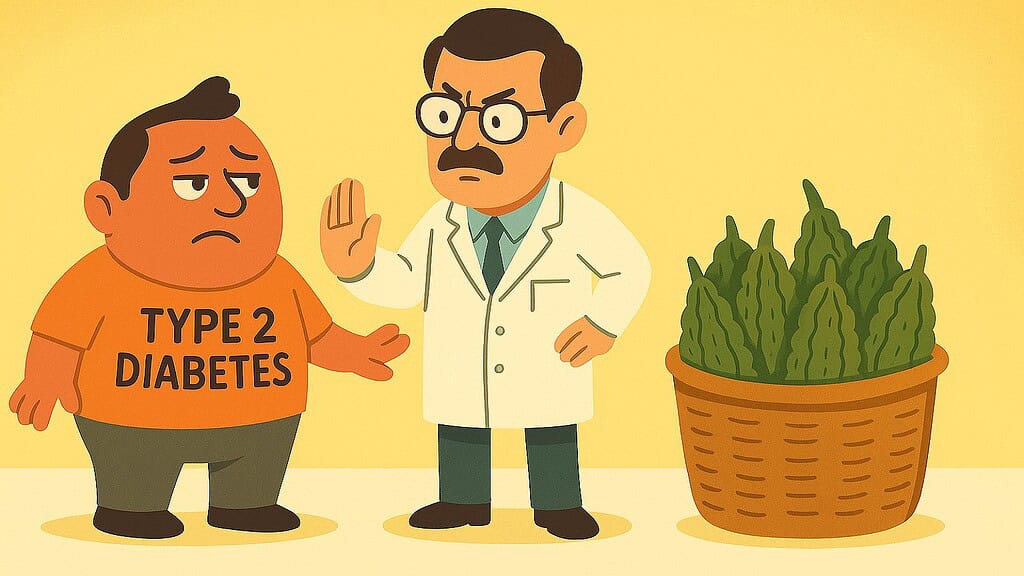Table of Contents
Introduction: When Type 2 Diabetes Fell in Love with Sweetness
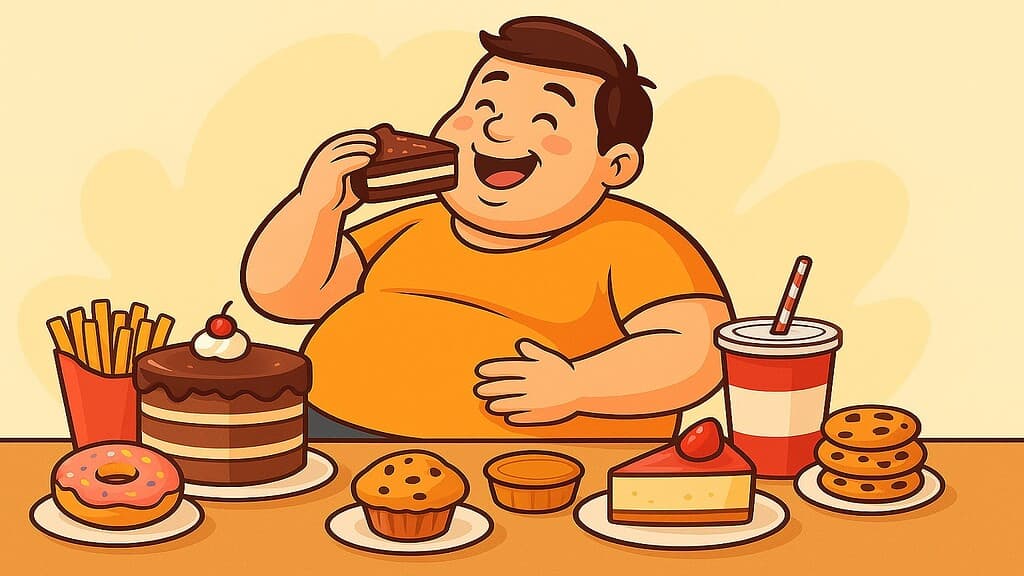
Type 2 Diabetes was quite the charmer. He had a way with the ladies. Every weekend, he’d show up at parties with a different date on his arm. Sometimes it was Lady Cake, dripping in frosting and sprinkles. Other times, he’d waltz in with Miss Soda, all bubbly and effervescent. His social calendar stayed packed.
The relationship with Ice Cream lasted three wonderful summers. She was smooth, she was cold, she knew how to make him feel good. Fried Food became his Tuesday night regular. She arrived hot and crispy, never asking too many questions. Junk Foods were his weekend crew. They never judged him. They just showed up ready to party.
Alcohol played the role of his sophisticated mistress. She made him feel relaxed and worldly. She told him he deserved to unwind. Life felt sweet when Type 2 Diabetes surrounded himself with these companions. They made him forget his responsibilities. They whispered that tomorrow could wait.
His friends called him lucky. His family stopped asking when he’d settle down. Type 2 Diabetes had built himself a candy-coated kingdom. He was the king of excess, the sultan of sugar. Every meal became an adventure. Every snack told a love story.
But fairy tales have a way of ending. Sometimes a villain appears. Sometimes reality knocks on the door. For Type 2 Diabetes, that knock came in the form of a stern man in a white coat. The Doctor had arrived, and he was not amused by the romance.
Table 1: Clinical Understanding of Type 2 Diabetes Mellitus
(The following table contains evidence-based medical information, not satirical content)
| Aspect | Scientific Information |
|---|---|
| Definition | A chronic metabolic disorder characterized by insulin resistance and relative insulin deficiency, leading to elevated blood glucose levels |
| Global Prevalence | Approximately 537 million adults worldwide have diabetes, with Type 2 accounting for 90-95% of all cases |
| Primary Risk Factors | Obesity, physical inactivity, unhealthy diet, family history, age over 45, hypertension, and abnormal cholesterol levels |
| Pathophysiology | Insulin resistance in muscle, fat, and liver cells combined with progressive pancreatic beta-cell dysfunction |
| Diagnostic Criteria | Fasting plasma glucose ≥126 mg/dL, HbA1c ≥6.5%, or 2-hour plasma glucose ≥200 mg/dL during oral glucose tolerance test |
| Major Complications | Cardiovascular disease, neuropathy, nephropathy, retinopathy, foot ulcers, and increased infection risk |
Type 2 Diabetes: The Casanova of the Kitchen
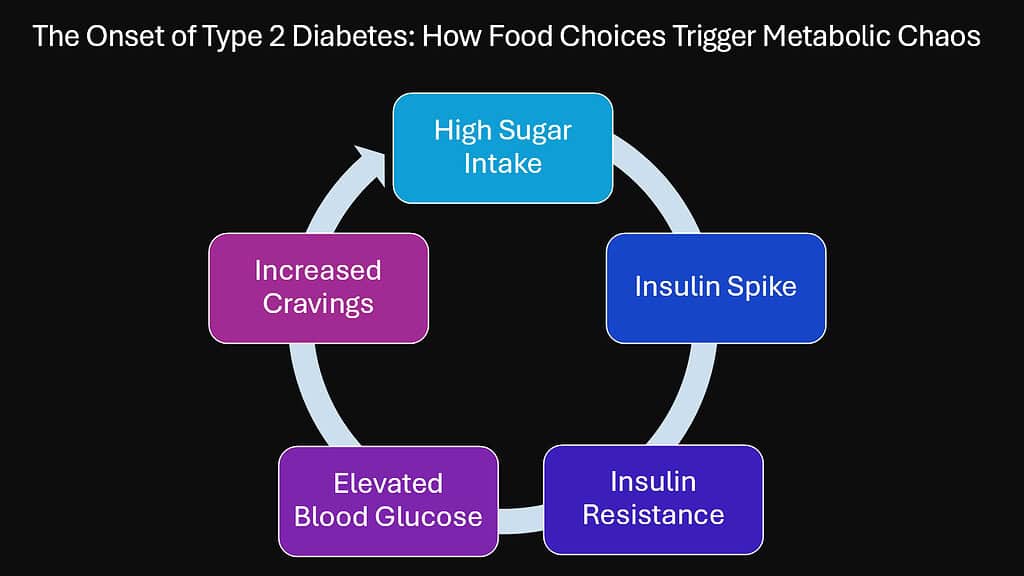
Type 2 Diabetes knew every restaurant in town by name. He could sweet-talk his way into any bakery. The pastry chefs knew his order before he walked through the door. Three donuts, extra glaze, hold the guilt.
His relationship with Lady Cake went deeper than most people understood. She came in many forms. Birthday Cake arrived with candles and wishes. Chocolate Cake wore dark, seductive layers. Cheesecake brought sophistication to the table. Each one offered something different, but they all promised the same thing: pure, uncomplicated pleasure.
Miss Soda sparkled in his life like champagne at midnight. She came in colors: cola brown, orange fizz, lemon-lime bright. She never demanded commitment. Just twist the cap and she was ready. Two liters of devotion, served cold. Diet versions tried to seduce him too, but Type 2 Diabetes was a purist. He wanted the real thing, sugar and all.
Ice Cream knew all his moods. Rocky Road understood his troubles. Mint Chocolate Chip cooled his frustrations. Cookie Dough reminded him of childhood. She lived in his freezer, always available for late-night conversations. Three scoops solved most problems. Four scoops solved the rest.
Fried Food never pretended to be healthy. She was honest about who she was. French fries came golden and salty. Chicken wings arrived hot and spicy. Onion rings showed up in crispy circles of joy. She didn’t apologize for her cooking method. She embraced the oil, the crunch, the immediate satisfaction.
Junk Foods traveled in groups. Chips brought the party. Cookies baked up sweet memories. Candy bars offered quick energy. Pizza delivered cheesy promises. They all had one thing in common: they made life taste better. They turned ordinary evenings into celebrations.
Alcohol played a different game. She was classy, refined, expensive. Wine spoke in French accents. Beer told old stories. Whiskey burned with truth. She convinced Type 2 Diabetes that he was living his best life. One more drink, one more toast, one more reason to forget tomorrow.
Type 2 Diabetes loved them all. He refused to choose. Why settle for one when the buffet stretched endlessly? His heart had room for everyone. His stomach expanded to accommodate the love.
Table 2: Dietary Factors Contributing to Type 2 Diabetes Development
(The following table presents peer-reviewed nutritional research findings)
| Dietary Component | Impact on Type 2 Diabetes Risk | Mechanism |
|---|---|---|
| Added Sugars and Sugary Beverages | Increases risk by 20-26% with daily consumption | Rapid glucose spikes, increased insulin demand, promotes visceral fat accumulation |
| Refined Carbohydrates | Higher glycemic load associated with 40% increased risk | Quick digestion leads to postprandial hyperglycemia and insulin resistance |
| Saturated and Trans Fats | Each 5% increase in trans fat intake raises risk by 39% | Promotes inflammation, impairs insulin signaling pathways, increases LDL cholesterol |
| Red and Processed Meats | Daily consumption increases risk by 51% for processed meats | High in saturated fats and advanced glycation end products that worsen insulin sensitivity |
| Ultra-Processed Foods | Regular consumption associated with 12% higher diabetes incidence | Contains additives, high sodium, unhealthy fats, and refined sugars that disrupt metabolism |
| Excessive Alcohol | Heavy drinking increases risk by 43% compared to moderate intake | Damages pancreatic cells, contributes to weight gain, interferes with glucose regulation |
Then Came the Villain: Doctor vs. Type 2 Diabetes
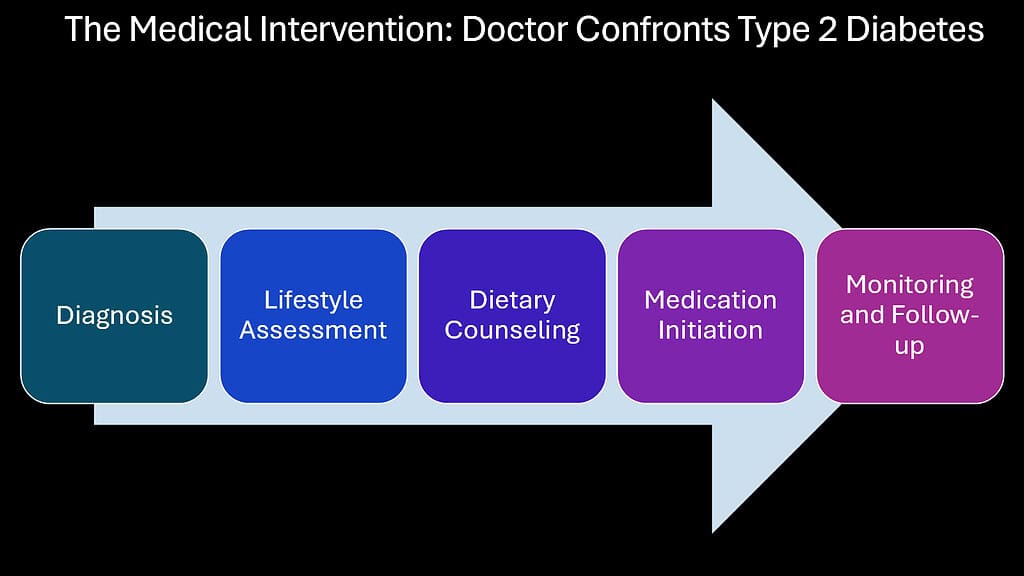
The Doctor entered like a storm. His white coat billowed. His stethoscope swung like a weapon. His face carried the expression of someone who had seen this story before and knew exactly how it ended. Badly.
He slammed test results on the table. Numbers glared back at Type 2 Diabetes. Glucose levels, cholesterol readings, blood pressure measurements. Each one screamed danger. Each one told tales of the sweet life gone sour.
“Your pancreas is exhausted,” the Doctor announced. His voice cut through the room like a scalpel. “Your insulin production is failing. Your cells are resistant. Your kidneys are starting to struggle. Your heart is under siege.”
Type 2 Diabetes tried to laugh it off. He had heard warnings before. He always bounced back. Tomorrow he would start exercising. Next week he would eat better. Soon, definitely soon, he would make changes.
“Soon isn’t good enough,” the Doctor said. His eyes narrowed. This was the moment. The ultimatum. The threat that would change everything.
“You will marry Bitter Gourd,” the Doctor declared. “Or you will die.”
Type 2 Diabetes laughed. Surely this was a joke. Bitter Gourd? That wrinkled, green, unappetizing vegetable? The one that made faces scrunch up in disgust? The one that tasted like punishment?
But the Doctor was not joking. He pulled out a wand that looked suspiciously like a prescription pad. He began casting spells. Magical medical incantations flowed from his mouth. Big words like “glycemic control” and “insulin sensitivity” and “complications prevention.”
The spell worked faster than Type 2 Diabetes expected. His family fell under its influence first. His mother, who used to bake him cookies, now spoke only of blood sugar management. His father, who took him for burger runs, suddenly quoted studies about dietary interventions.
His friends changed too. They stopped inviting him to all-you-can-eat buffets. They suggested walks instead of movie marathons. They talked about meal planning and portion control. Everyone agreed: Bitter Gourd was the answer. The marriage must happen.
Type 2 Diabetes protested. He pleaded. He bargained. Maybe he could just cut back a little? Maybe he could see Soda only on weekends? But the spell had done its work. Everyone around him believed in the Doctor’s prescription. Everyone except Type 2 Diabetes himself.
Table 3: Medical Management Approaches for Type 2 Diabetes
(The following table summarizes clinical treatment guidelines from endocrinology research)
| Treatment Category | Primary Interventions | Expected Outcomes |
|---|---|---|
| Lifestyle Modifications | Medical nutrition therapy, 150 minutes weekly moderate exercise, weight loss of 5-10% body weight | Can reduce HbA1c by 1-2%, improves insulin sensitivity, may delay medication need |
| First-Line Medication | Metformin (1500-2000 mg daily) | Reduces HbA1c by 1-1.5%, minimal hypoglycemia risk, cardiovascular benefits |
| Injectable Therapies | GLP-1 receptor agonists (e.g., semaglutide, liraglutide) | Reduces HbA1c by 0.8-1.5%, promotes weight loss of 3-5 kg, cardiovascular protection |
| Insulin Therapy | Basal insulin added when other therapies insufficient | Achieves target glucose control, dose adjusted based on monitoring |
| Blood Glucose Monitoring | Self-monitoring 1-4 times daily depending on regimen | Enables treatment adjustments, prevents hypoglycemia, tracks patterns |
| Comprehensive Care | Regular screening for complications, blood pressure control, lipid management, aspirin therapy | Reduces microvascular complications by 25%, cardiovascular events by 33% |
The Breakup Parade: Type 2 Diabetes Loses His Lovers
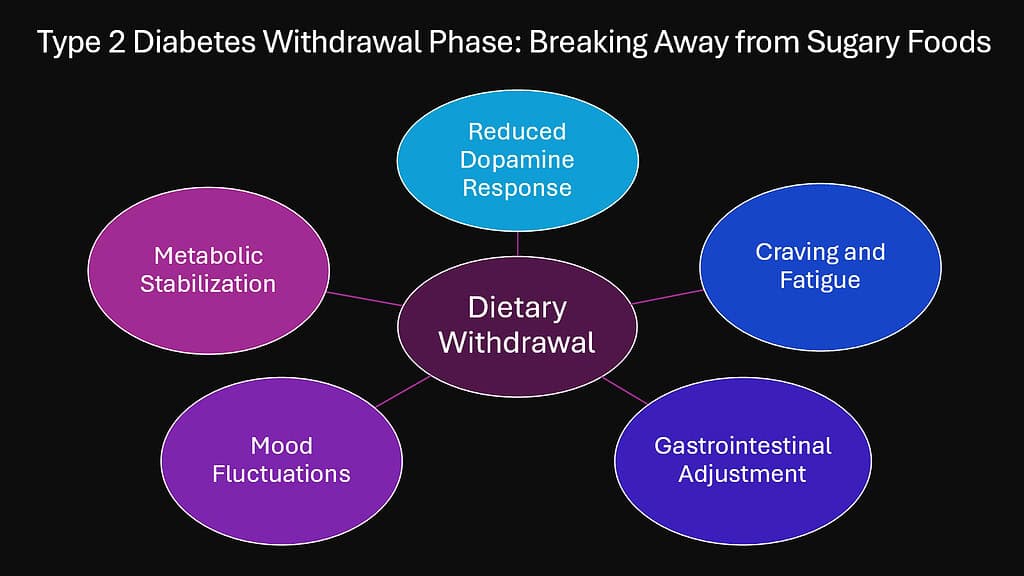
The breakups started on a Monday. Type 2 Diabetes woke to find Lady Cake had left a note. “It’s not you, it’s your pancreas,” she wrote. “I can’t watch you destroy yourself. Goodbye.”
Miss Soda didn’t even leave a message. She just disappeared from his life. Her spot in the refrigerator sat empty. Her bottles no longer cluttered his counter. The fizz had gone out of their relationship.
Ice Cream’s departure hurt the most. They had shared so many late nights together. She knew his secrets. She had comforted him through difficult times. But even she couldn’t stay. “You need someone who’s good for you,” she said through frozen tears. “That someone isn’t me.”
Fried Food tried to be brave about it. “I knew this day would come,” she said. Her crispy exterior couldn’t hide her sadness. “I’m not healthy for you. I never was. You deserve better.” She packed her air fryer and left without looking back.
Junk Foods organized a group exit. They stood together, a united front of chips, cookies, and candy. “We’re enabling your destruction,” Chips spoke for everyone. “Real friends don’t do that. We have to let you go.” They filed out one by one, their packages rustling their goodbyes.
Alcohol lingered longest. She poured herself one last drink. “I made you think you were happy,” she admitted. “But I was making everything worse.” She raised her glass in a final toast. “To your health. May you find it without me.”
Type 2 Diabetes stood alone in his empty kitchen. The refrigerator hummed its neutral song. The pantry echoed with absence. Everyone he loved had abandoned him. Everyone he trusted had walked away.
He tried to remember what life felt like before the Doctor’s ultimatum. Before the test results. Before the spell. Had he really been happy? Or had he been slowly dying while thinking he was living?
His phone stayed silent. No more late-night food delivery apps tempting him. No more notifications about happy hour specials. His old life had been deleted, cleared out like expired groceries.
The loneliness tasted bitter. Which was fitting, considering what came next.
Table 4: Foods to Limit or Avoid in Type 2 Diabetes Management
(The following table is based on nutritional guidelines from diabetes associations worldwide)
| Food Category | Specific Examples | Reason for Restriction | Recommended Frequency |
|---|---|---|---|
| Sugar-Sweetened Beverages | Regular soda, sweet tea, energy drinks, fruit juice | Rapid blood glucose elevation, high caloric density, no nutritional benefit | Avoid completely; choose water, unsweetened tea |
| Refined Baked Goods | White bread, pastries, donuts, cakes, cookies | High glycemic index, low fiber, promotes blood sugar spikes | Minimize; choose whole grain alternatives |
| Fried and High-Fat Foods | French fries, fried chicken, onion rings, potato chips | High in trans and saturated fats, increases cardiovascular risk | Occasional only; prefer baked, grilled, steamed |
| Processed Meats | Bacon, sausages, hot dogs, deli meats | High sodium and preservatives, linked to increased diabetes complications | Limit to once weekly; choose lean proteins |
| Full-Fat Dairy Products | Whole milk, cream, butter, full-fat cheese | High saturated fat content worsens insulin resistance | Switch to low-fat or fat-free versions |
| Candy and Sweets | Chocolate bars, gummy candies, ice cream, sweetened desserts | Pure sugar with minimal nutrients, causes glucose instability | Reserve for rare occasions; practice portion control |
Enter Bitter Gourd: Type 2 Diabetes Meets His Match
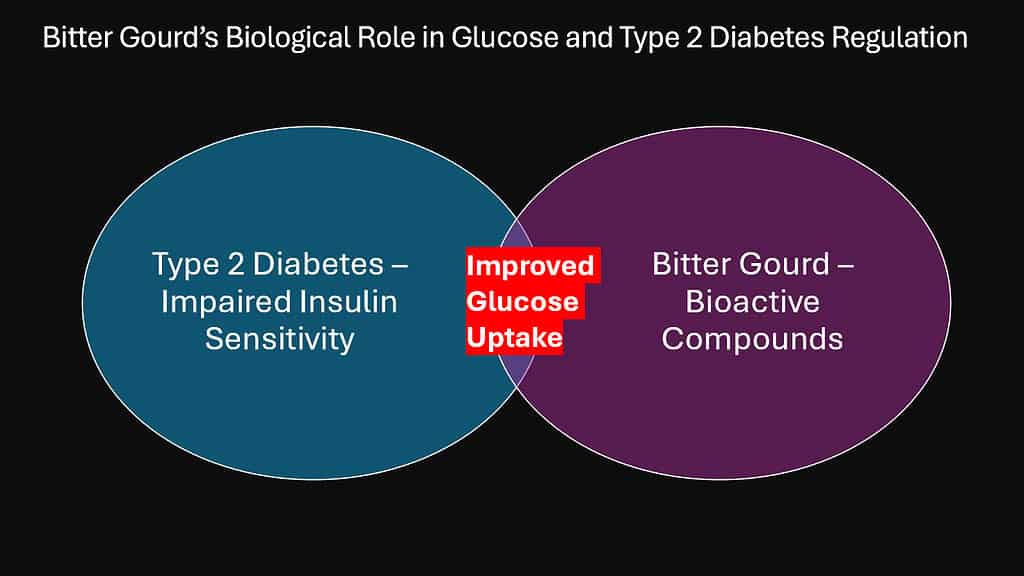
Bitter Gourd arrived without fanfare. No grand entrance. No dramatic music. She simply appeared at his door one morning, green and unimpressive.
Her skin told stories of a rough life. Wrinkles covered her surface like battle scars. She wasn’t smooth like Ice Cream. She didn’t sparkle like Miss Soda. She looked like she had crawled out of a garden and forgotten to make herself presentable.
“I’m your arranged bride,” she announced. Her voice carried no romance, no seduction. Just facts delivered plainly.
Type 2 Diabetes stared. This couldn’t be real. The Doctor had mentioned her, but he hadn’t really believed it would come to this. Bitter Gourd? This was the answer? This wrinkled, green vegetable was supposed to replace all his former loves?
“I didn’t agree to this,” he protested. His voice sounded weak even to himself.
“Neither did I,” Bitter Gourd replied. “But here we are. The Doctor says we’re compatible. Your body needs what I provide. My compounds work with your metabolism.”
She stepped inside without invitation. Her green aura filled the room. She smelled earthy, honest, unprocessed. Everything about her was the opposite of what Type 2 Diabetes had loved before.
“I won’t pretend this is a love match,” Bitter Gourd continued. She didn’t sugarcoat anything. Maybe because she contained no sugar to coat with. “I’m bitter. That’s my nature. I don’t taste good. I don’t make you feel instantly happy. But I will keep you alive.”
Type 2 Diabetes wanted to slam the door. He wanted to call his old girlfriends back. Surely there was some compromise? Maybe he could have just a little cake? Perhaps Ice Cream could visit occasionally?
But his family had arranged everything. The wedding date was set. The Doctor had prescribed it. Bitter Gourd had moved into his kitchen. She was unpacking her nutrients, her bioactive compounds, her hypoglycemic properties.
“You’ll learn to tolerate me,” Bitter Gourd said. It wasn’t a promise. It was a prediction. “Eventually, you might even appreciate what I do for you.”
Type 2 Diabetes doubted that very much. How could he appreciate bitterness when he had known such sweetness? How could wrinkled green replace smooth cream? This marriage was doomed before it started.
Bitter Gourd began preparing herself. She sliced herself into rings. “I’m best consumed fresh,” she explained. “Some people cook me with spices to mask my bitterness. Others juice me. A few brave souls eat me raw.”
Type 2 Diabetes felt his future stretching before him. A long, bitter future with a wrinkled green vegetable. This was not how he had imagined his life would turn out.
Table 5: Nutritional Profile and Bioactive Compounds in Bitter Gourd
(The following table contains scientifically verified nutritional data)
| Component | Content per 100g | Biological Function in Diabetes Management |
|---|---|---|
| Calories | 17 kcal | Low caloric density supports weight management |
| Carbohydrates | 3.7 g (mostly fiber) | Minimal impact on blood glucose, high fiber aids glycemic control |
| Protein | 1.0 g | Provides essential amino acids without carbohydrate load |
| Charantin | 0.09-0.15% | Insulin-like peptide that promotes glucose uptake in cells |
| Polypeptide-p | Present in seeds and fruit | Acts as plant insulin, reduces blood glucose levels |
| Vicine | Trace amounts | Contributes to hypoglycemic effects |
| Momordicin | 0.02-0.05% | Bitter compound with anti-diabetic properties |
| Vitamin C | 84 mg | Antioxidant protection against oxidative stress from high glucose |
| Dietary Fiber | 2.8 g | Slows carbohydrate absorption, improves postprandial glucose response |
The Forced Marriage: Type 2 Diabetes Says ‘I Don’t’
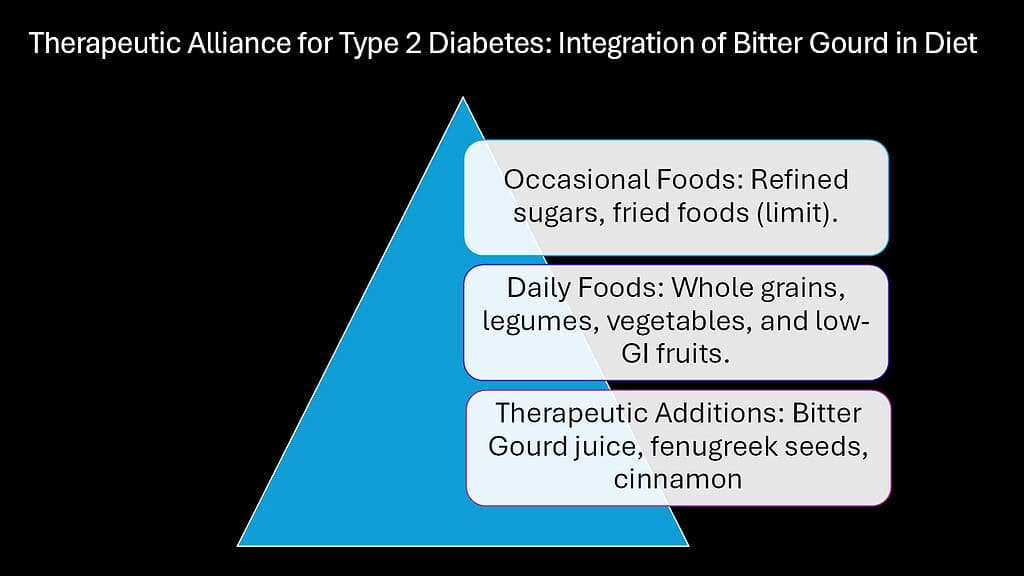
The wedding day arrived like an execution. Type 2 Diabetes wore a suit that felt too tight. His collar choked him. His shoes pinched. Everything about this day felt wrong.
Bitter Gourd stood at the altar in her green dress. She made no attempt to look beautiful. She was what she was: bitter, wrinkled, honest. At least she wasn’t pretending.
The pastor cleared his throat. Type 2 Diabetes’s family filled the pews. His mother dabbed her eyes, but these weren’t tears of joy. More like tears of relief that her son was finally making a healthy choice. His friends sat scattered throughout the church, all under the Doctor’s spell.
The Doctor himself sat in the front row. His prescription pad rested on his lap like a wedding gift. He watched with satisfaction. Another patient saved from himself. Another intervention successful.
“Dearly beloved,” the pastor began. His voice echoed in the quiet church. “We are gathered here today to join Type 2 Diabetes and Bitter Gourd in metabolic matrimony.”
Type 2 Diabetes glanced at the door. Could he run? Would his legs carry him away from this green nightmare? But the spell held firm. His feet stayed planted.
The ceremony continued. Words about health and wellness replaced traditional vows. The pastor spoke of glucose management and insulin sensitivity instead of love and cherishing. This was a medical marriage, not a romantic one.
“Type 2 Diabetes,” the pastor finally asked, “do you take Bitter Gourd to be your lawfully wedded partner? To consume her daily, in sickness and in health, for better blood sugar levels, till optimal health do you part?”
This was the moment. The final chance to resist.
“I don’t,” Type 2 Diabetes said clearly.
The church fell silent. Everyone stared. Had he really just refused?
But the pastor continued as if nothing had happened. “And do you, Bitter Gourd, take Type 2 Diabetes to be your metabolic partner? To regulate his glucose, to improve his insulin sensitivity, to reduce his complications?”
“I do,” Bitter Gourd replied. She had expected his resistance. She wasn’t offended.
The pastor smiled. “Then by the power vested in me by the medical establishment and common sense, I now pronounce you metabolically bound. Type 2 Diabetes, you may now consume your bride.”
“But I said I don’t!” Type 2 Diabetes protested. His voice rose in panic.
His mother stood up. “Darling, we heard you. But your pancreas says you do. Your kidneys say you do. Your heart says you do.”
The Doctor nodded. “Your body has spoken louder than your words.”
Bitter Gourd approached him. She held out a slice of herself. “Shall we begin?” she asked. No romance. Just practicality.
Type 2 Diabetes looked around the church. Everyone waited. Everyone expected him to do this. Even his refusal had been ignored. The marriage was happening whether he consented or not.
He took the slice. It felt cool in his hand. Green and unappetizing. He brought it closer to his mouth.
“Welcome to married life,” Bitter Gourd said. “It’s not sweet. But you’ll survive it.”
Table 6: Clinical Evidence for Bitter Gourd’s Anti-Diabetic Effects
(The following table summarizes findings from peer-reviewed medical studies)
| Study Type | Sample Size | Key Findings | Blood Glucose Reduction |
|---|---|---|---|
| Randomized Controlled Trial (2011) | 42 patients with Type 2 diabetes | Fresh bitter gourd consumption showed significant glucose reduction | Fasting glucose decreased by 15-20 mg/dL over 4 weeks |
| Meta-Analysis (2018) | 7 clinical trials, 479 participants | Consistent hypoglycemic effects across multiple preparations | Average HbA1c reduction of 0.25-0.5% |
| Clinical Trial (2015) | 95 patients monitored for 3 months | Bitter gourd extract improved insulin secretion and sensitivity | Postprandial glucose reduced by 54 mg/dL on average |
| Comparative Study (2017) | 60 newly diagnosed patients | Bitter gourd juice showed effects comparable to early-stage metformin | Fasting glucose decreased by 18-25 mg/dL |
| Long-term Observation (2019) | 134 patients over 12 months | Regular consumption associated with fewer diabetic complications | Improved kidney function markers, reduced neuropathy symptoms |
| Dose-Response Study (2020) | 88 participants testing various amounts | Optimal effects at 50-100 ml juice or equivalent raw consumption daily | Dose-dependent glucose reduction, plateau at higher doses |
Married Life: Type 2 Diabetes Learns the Bitter Truth
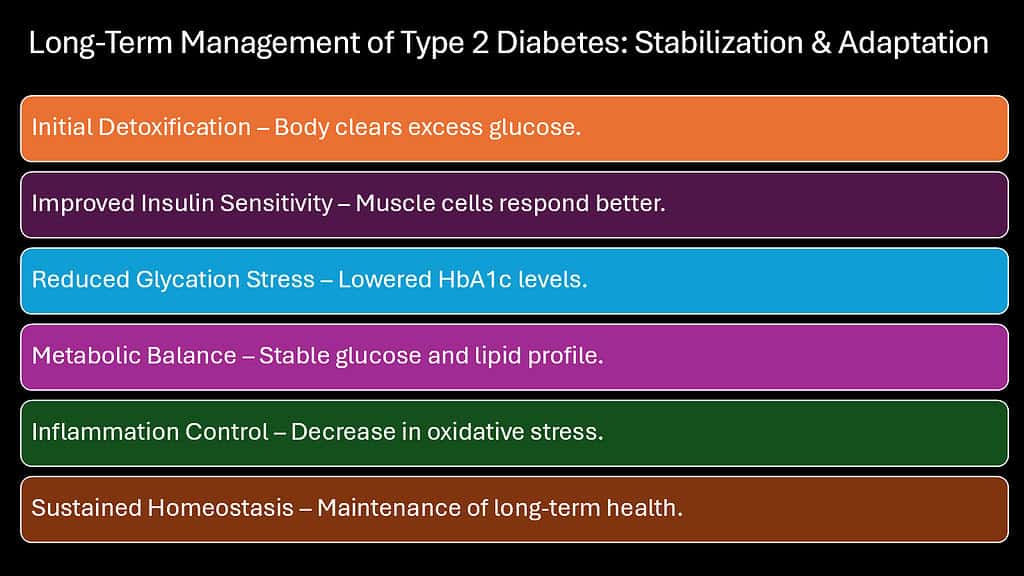
The honeymoon phase never arrived. Bitter Gourd moved into Type 2 Diabetes’s life with no pretense of romance. She organized his refrigerator. She cleared space in his pantry. She established rules.
“I’m here every morning,” she announced. “Fresh, if possible. Juiced if you prefer. Cooked if you must. But I’m here. Daily. Non-negotiable.”
Type 2 Diabetes tried to negotiate anyway. “Maybe we could skip weekends?”
“Your glucose doesn’t skip weekends,” Bitter Gourd replied. “Neither do I.”
She was strict but not cruel. She understood his mourning for the sweet life. She saw how he stared longingly at dessert menus. She noticed when he slowed down while passing ice cream shops.
“I’m not asking you to love me,” Bitter Gourd said one morning. “I’m asking you to let me help you.”
The first month was terrible. Type 2 Diabetes gagged on her bitterness. He tried disguising her with spices. He blended her with other vegetables. He cooked her until she barely resembled herself. Nothing made her pleasant.
But something was changing. His energy levels started improving. The constant thirst that had plagued him began fading. His vision cleared slightly. His wounds healed faster.
The Doctor confirmed it at the next checkup. “Your numbers are improving,” he said, reviewing test results. “Your fasting glucose has dropped. Your HbA1c is moving in the right direction.”
Type 2 Diabetes wanted to credit anything else. Maybe the exercise he had started? Perhaps the portion control? But deep down, he knew the truth. Bitter Gourd was working.
By the third month, something strange happened. Type 2 Diabetes stopped fighting quite so hard. He still didn’t enjoy her taste, but he had developed a routine. Morning bitter gourd juice became part of his day. He stopped making faces while drinking it.
Bitter Gourd noticed the shift. “You’re adapting,” she observed. “Humans are good at that.”
“I’m surviving,” Type 2 Diabetes corrected.
“Same thing,” Bitter Gourd replied. “And survival is no small achievement.”
She shared more about herself. How she had helped countless others. How her compounds had been studied in laboratories around the world. How traditional medicine had used her for centuries.
“I’m not glamorous,” she admitted. “I’ll never be as popular as Ice Cream or as exciting as Soda. But I’m effective. And in the end, that’s what matters.”
Type 2 Diabetes’s family noticed the changes. His mother stopped worrying constantly. His father commented on how much better he looked. His friends invited him out again, confident he wouldn’t make destructive choices.
Even the Doctor seemed pleased. “The marriage is working,” he declared. “Your commitment to Bitter Gourd is saving your life.”
Type 2 Diabetes wouldn’t call it commitment exactly. More like resignation. Acceptance. But whatever the name, it was happening. He was living with Bitter Gourd, and somehow, against all expectations, they were making it work.
Table 7: Mechanisms of Action: How Bitter Gourd Improves Glucose Metabolism
(The following table details the biochemical processes validated by scientific research)
| Mechanism | Specific Action | Clinical Significance |
|---|---|---|
| Enhanced Glucose Uptake | Increases GLUT4 transporter expression in muscle and fat cells | Improves cellular glucose utilization without requiring additional insulin |
| Pancreatic Beta-Cell Protection | Reduces oxidative stress and inflammation in insulin-producing cells | Preserves remaining insulin production capacity |
| Inhibition of Glucose Absorption | Slows intestinal glucose absorption through alpha-glucosidase inhibition | Reduces postprandial blood glucose spikes |
| Increased Insulin Secretion | Stimulates pancreatic beta cells to release insulin in glucose-dependent manner | Improves insulin availability when needed most |
| Reduced Hepatic Glucose Production | Inhibits gluconeogenesis in the liver | Lowers fasting blood glucose levels |
| Improved Lipid Metabolism | Reduces triglycerides and LDL cholesterol, increases HDL | Addresses cardiovascular risk factors common in diabetes |
| Anti-Inflammatory Effects | Reduces inflammatory markers like TNF-alpha and IL-6 | Decreases insulin resistance caused by chronic inflammation |
| Antioxidant Activity | Neutralizes free radicals generated by hyperglycemia | Prevents oxidative damage to blood vessels and organs |
Conclusion: Happily Bitter After: The Lesson for Type 2 Diabetes
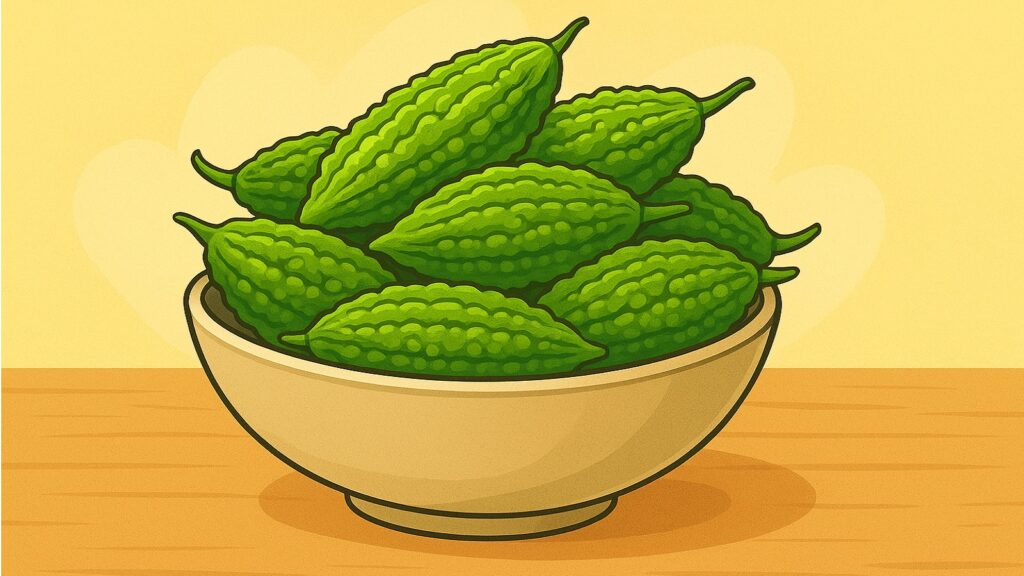
Six months into the marriage, Type 2 Diabetes sat across from the Doctor for his regular checkup. The test results spread between them told a story of transformation.
“Your HbA1c has dropped significantly,” the Doctor said. Pride colored his voice. “Your kidney function is stable. Your retinopathy hasn’t progressed. The neuropathy symptoms have decreased.”
Type 2 Diabetes nodded. He had felt these changes before seeing them on paper. His body felt different. Lighter. Clearer. More stable.
“How’s married life with Bitter Gourd?” the Doctor asked with a slight smile.
Type 2 Diabetes considered the question. How was it? Still bitter, certainly. Still not sweet. Still nothing like his old relationships with cake and soda. But somehow, it had become manageable. Almost comfortable.
“She’s growing on me,” he admitted. “Like a fungus.”
The Doctor laughed. “That’s the spirit.”
At home, Bitter Gourd waited in the refrigerator. She never demanded attention. She never threw tantrums. She simply existed, ready to do her job. Day after day, she showed up. Consistent. Reliable. Effective.
Type 2 Diabetes prepared his morning juice. His hands moved automatically now. Wash the bitter gourd. Slice it. Blend it. Drink it. The routine had become second nature.
“I’ve been thinking,” Type 2 Diabetes said to Bitter Gourd as he poured the green liquid. “About my old girlfriends. They made me feel good temporarily. But you actually make me feel good long-term.”
“That’s the difference between pleasure and health,” Bitter Gourd replied. “One is exciting but destructive. The other is boring but sustainable.”
“I wouldn’t call you boring anymore,” Type 2 Diabetes said. “Maybe just… acquired taste.”
Bitter Gourd smiled, if vegetables could smile. “I’ll take it.”
Type 2 Diabetes realized something profound. His old relationships had been based on immediate gratification. They felt good in the moment but slowly destroyed him. Bitter Gourd offered something different: delayed gratification, long-term benefit, actual care.
She wasn’t trying to make him happy. She was trying to keep him alive. And surprisingly, staying alive had made him happier than temporary sweetness ever did.
His friends noticed the change. “You seem different,” one commented. “Calmer. Healthier.”
“I got married,” Type 2 Diabetes explained. “To someone who’s good for me.”
He occasionally thought about his old loves. Ice Cream still looked tempting in advertisements. Soda still sparkled in convenience store coolers. Cake still appeared at birthday parties. But the desperate need for them had faded. He could walk past without the old ache.
Bitter Gourd had taught him something unexpected: bitterness wasn’t punishment. It was medicine. It was wisdom. It was the taste of taking care of yourself even when it wasn’t fun.
The Doctor’s forced marriage had seemed like tyranny. But looking back, Type 2 Diabetes understood it differently now. Sometimes love means intervention. Sometimes caring means being the villain. Sometimes the best prescription comes from someone willing to tell hard truths.
Type 2 Diabetes raised his glass of bitter gourd juice. “To you,” he said. “My wrinkled, green, honest partner. Thank you for saving my life.”
“You’re welcome,” Bitter Gourd replied. “Now drink me before I lose my nutrients.”
Type 2 Diabetes drank. The bitterness no longer shocked his system. It had become familiar. Almost comforting. The taste of choosing health over pleasure. The flavor of survival over sweetness.
He had learned the bitter truth: sometimes the best relationships aren’t the sweetest ones. Sometimes what you need isn’t what you want. Sometimes bitterness saves lives while sweetness slowly kills.
And in that knowledge, Type 2 Diabetes found something unexpected. Not happiness exactly. Not romance. But something more valuable: peace. Stability. A future that extended beyond immediate gratification.
He was happily bitter after, and the bitterness felt sweeter than the sweets.
Table 8: Comprehensive Benefits of Regular Bitter Gourd Consumption for Type 2 Diabetes
(The following table synthesizes evidence from multiple clinical studies and systematic reviews)
| Health Outcome | Observed Benefit | Time Frame for Effects | Additional Notes |
|---|---|---|---|
| Fasting Blood Glucose | Reduction of 15-30 mg/dL on average | 2-4 weeks of daily consumption | Effects sustained with continued use |
| HbA1c Levels | Decrease of 0.25-0.7% | 8-12 weeks minimum | Comparable to lifestyle interventions |
| Postprandial Glucose | Reduction of 40-60 mg/dL | Immediate to 2 weeks | Most significant after meals high in carbohydrates |
| Insulin Sensitivity | Improvement of 15-25% | 4-8 weeks | Measured by HOMA-IR and glucose tolerance tests |
| Body Weight | Modest reduction of 1-3 kg | 12-16 weeks | Enhanced when combined with calorie control |
| Lipid Profile | Decrease in triglycerides by 10-15%, improvement in HDL | 8-12 weeks | Reduces cardiovascular risk factors |
| Oxidative Stress Markers | Reduction of 20-30% in malondialdehyde and other markers | 4-6 weeks | Protects against diabetic complications |
| Kidney Function | Stabilization of creatinine levels, reduced microalbuminuria | 12-24 weeks | Prevents progression of diabetic nephropathy |
| Neuropathy Symptoms | Reduced pain and tingling in 30-40% of patients | 8-16 weeks | Subjective improvement, quality of life benefits |
This article is only for informational purposes. It combines humor and satire with scientifically accurate information about Type 2 Diabetes management. While the narrative is fictional and comedic, the medical information in tables and in images is based on peer-reviewed research and clinical guidelines. Do not make your critical decision solely based on the information provided here. Always consult healthcare professionals for personalized medical advice.
Read More Science and Space Related Articles
- Anthropomorphism: 6 Brilliant Benefits and Risks in AI
- Millisecond Pulsars: 6 Incredible Insights Driving Science
- Origin of Life: 8 Stunning Theories That Spark Curiosity
- Apples Boost Gut Health: 6 Brilliant Benefits Revealed
- 8 Amazing Fruit Families With Their Nutrition Secrets
- Top 5 Bitter Vegetables That Are Incredible For Our Health

